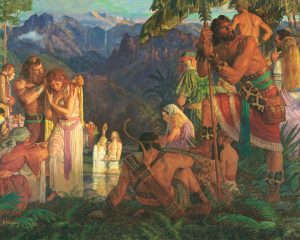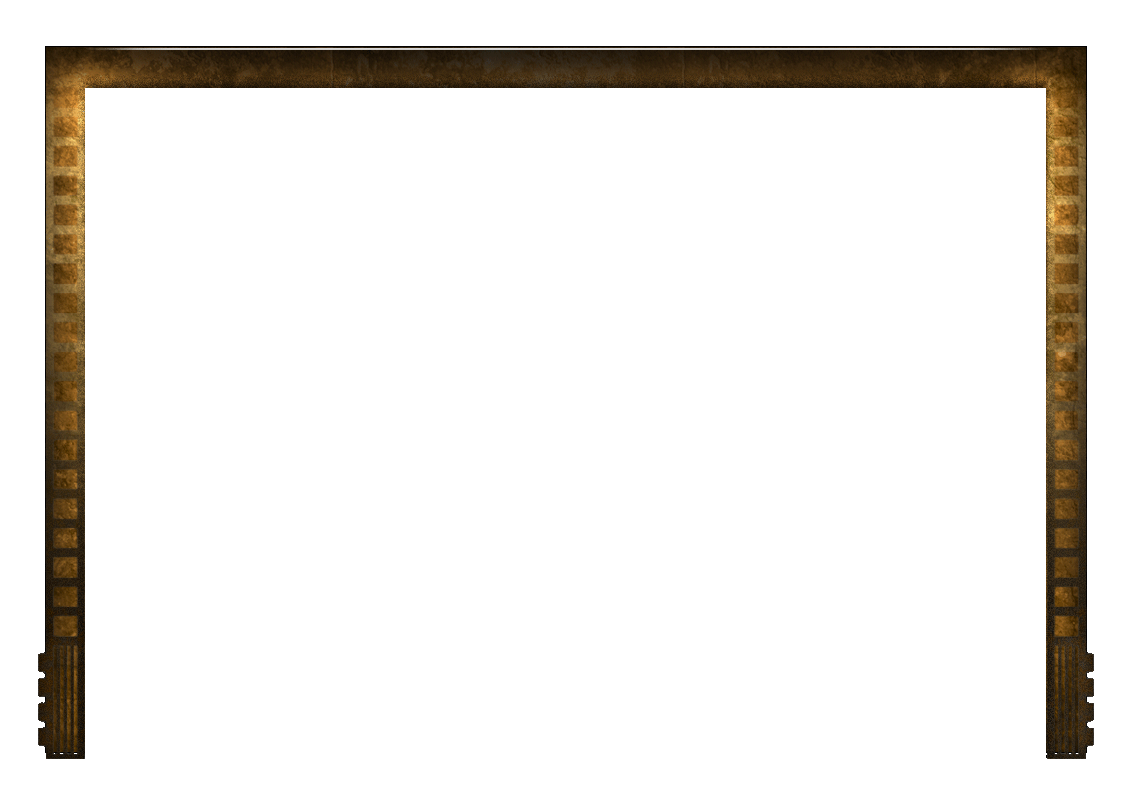The New World
The second DVD in the Journey of Faith series discusses the religious milieu, culture, the land, and language surrounding the descendants of Lehi and Sariah in the New World. Lehi’s son, Nephi, begins the Book of Mormon account in 600 bc, preserving it by engraving on metal plates. The narrative did not come to light until the 1820s, when by divine revelation, Joseph Smith was directed to the plates and unearthed them from a hill in upstate New York. From them he translated the Book of Mormon: Another Testament of Jesus Christ.
 The Book of Mormon contains accounts by several different people over a thousand years, harmonized into a whole narrative by a father and son, Mormon and Moroni, who lived around 400 ad., including the visit of Jesus Christ to the Nephite people in the Americas after His resurrection.
The Book of Mormon contains accounts by several different people over a thousand years, harmonized into a whole narrative by a father and son, Mormon and Moroni, who lived around 400 ad., including the visit of Jesus Christ to the Nephite people in the Americas after His resurrection.
This second article on external evidences focuses the cultural parallels between the Nephite civilization and the ancient inhabitants of the Americas.[1]
Although several theories have been advanced as to the location of the Book of Mormon narrative, the most work has been done in Mesoamerica. Starting in the 1950s, and fueled by his testimony of the Book of Mormon, John L. Sorenson, emeritus professor of archaeology at Brigham Young University, has studied and published on transoceanic migrations to the Americas, and the conditions such immigrants would have met.[2] It is principally because of his pioneering work and that of BYU’s New World Archaeological Foundation[3] that the most likely candidate for the setting of the Book of Mormon is Mesoamerica. Continuing Sorenson’s work, John E. Clark, professor of archaeology at BYU, has done extensive research in Mesoamerica.[4] Since Journey of Faith: The New World focuses on Mesoamerica, that will be the scope of this article.
An Ancient Civilization
The first question that could be posed is that if the Book of Mormon did not come through direct revelation, how could Joseph Smith have known so much about the ancient culture of Mesoamerica. As Sorenson elucidates, “Literally no person in Joseph Smith’s day knew or could have known enough facts about exotic Central America to depict the subtle and accurate picture of ancient life that we find as background for the Book of Mormon.”[5] In 1839, nine years after the publication of the Book of Mormon, John L. Stephens published his Incidents of Travel in Central America, Chiapas and Yucatan. Sorenson tells us:
Orson Pratt, an early leader in the Church of Jesus Christ of Latter-day Saints, is accurate in his recollection in 1849 that “no one will dispute the fact that the existence of antique remains in different parts of America was known long before Mr. Smith was born. But every well-informed person knows that . . . most of the discoveries made by Catherwood and Stephens were original—that most of the forty-four cities described by [Stephens’s book] had not been described by previous travelers.”[6]
The Maya People
Archaeology in Mesoamerica is in its relative infancy, but significant parallels have been established between the ancient Maya and the people of the Book of Mormon. Allen J. Christensen has linked the timing and form of King Benjamin’s speech in the Book of Mormon (Mosiah 2–6) to the Maya Harvest festival.[7] Lehi’s vision of the tree of life (1 Nephi 8) has parallels to many world religions.[8] But Christenson explores that of the ancient Maya in particular in his seminal work on the Popol Vuh, the creation story of the Maya:
Sacred trees, representing the power of life to grow from the underworld realm of the dead, are a common motif in the art and literature of the ancient Maya of Mesoamerica. Such trees are similar in concept to the tree of life described in the Book of Mormon, as well as to the mythic traditions of many other contemporary world cultures. Hieroglyphic inscriptions and sixteenth-century highland Maya texts describe a great world tree that was erected at the dawn of the present age to stand as the axis point of the cosmos. In its fruit-laden form, it personified the god of creation who fathered the progenitors of the Maya royal dynasty.[9]
Smiting off Arms
One of the most memorable (if gory) accounts in the Book of Mormon is that of Ammon, the son of Mosiah, and his brethren who went on a mission to the Lamanites after a remarkable conversion (see Mosiah 27–28; Alma 17–27). Ammon went down to one of the Lamanite kingdoms and became a servant. According to the text, those responsible for the flocks were attacked by rustlers. Ammon came to their defense in a unique way
…behold, every man that lifted his club to smite Ammon, he smote off their arms with his sword; for he did withstand their blows by smiting their arms with the edge of his sword, insomuch that they began to be astonished, and began to flee before him; yea, and they were not few in number; and he caused them to flee by the strength of his arm. (Alma 17:37).
Bruce Yerman informs us that this story:
…fits a cultural pattern known from pre-Spanish Mesoamerica. Cutting off an enemy’s arm in battle not only rendered him utterly helpless but also netted the victor a grisly trophy to carry from the scene of battle that would validate his prowess in hand-to-hand combat. Documents from Mexico and Guatemala reveal such a pre-Columbian custom. . . . In Mexico City’s National Palace, famed artist Diego Rivera represented the life of the Aztecs and their predecessors in a series of colorful and accurate murals. The one in the first corridor of the palace depicts the marketplace at Tlatelolco, a quarter of the Aztec capital metropolis that was made famous through vivid descriptions provided by the Spanish conquerors. This carefully researched Rivera mural shows a prostitute tempting men around her in the marketplace. They show off for her by flaunting tokens of wealth and power. One displays a precious jade necklace. Another admirer, a soldier, offers the woman “an arm of a white man, whom he surely had just defeated in combat.”[10]
The Popol Vuh also has reference to smiting off arms.
Weaponry
Warfare in the Book of Mormon is fairly prevalent, given the adversarial nature of Laman and Lemuel, the two oldest sons of Lehi. When the family split after they had settled in the New World, the rivalry between Laman and Lemuel and their younger brothers, led by Nephi, morphed into outright warfare that eventually led to the complete destruction of the Nephites by the Lamanites.[11] Matthew Roper has conducted some interesting research into swords in the Book of Mormon and their parallels to ancient Mesoamerican weapons.
Recent scholarship on Book of Mormon warfare suggests that the Mesoamerican weapon the macuahuitl fits the criteria for the Book of Mormon “sword.” . . . It is noteworthy that early Chroniclers of Mesoamerican culture such as Duran and Clavijero unashamedly describe this weapon as a sword. Modern Mesoamerican historians commonly use similar terminology.[12]
Roper also makes a case for the Book of Mormon “cimeter” (see Enos 1:20; Alma 27:29; 44:8). “The cimeter of the Book of Mormon is known today as a scimitar—a curved blade with the outer side sharpened. The bill-hook, ‘short-sword,’ and double-dagger are . . . Mesoamerican weapons that fit with the concept of scimitar.”[13]
It is hoped that this short survey of external evidences for the Book of Mormon’s authenticity will lead the reader to a great exploration by following the references in the footnotes.
[1] The Neal A. Maxwell Institute for Religious Scholarship has published several books that throw light on the ancient origins of the Book of Mormon. For instance, Daniel C. Peterson, Donald W. Parry, and John W. Welch, eds., Echoes and Evidences of the Book of Mormon (Provo, UT: FARMS, 2002). The Institute’s flagship publication, now titled Journal of Book of Mormon and Other Restoration Scripture, has published many articles dealing with internal and external evidences over the years.
[2] See a bibliography of his works. Those available online can be found at: John L. Sorenson bibliography.
[3] NWAF Archaeological Foundation.
[4] Clark’s online publications for the Maxwell Institute.
[5] John L. Sorenson, “How Could Joseph Smith Write So Accurately about Ancient American Civilization?”.
[6] Sorenson, “How Could Joseph Smith.”
[7] Allen J. Christenson, “Maya Harvest Festivals and the Book of Mormon,”.
[8] See John W. Welch and Donald W. Parry, eds., Tree of Life: From Eden to Eternity (Salt Lake City: Deseret Book, 2011).
[9] Allen J. Christenson, “The Sacred Tree of the Ancient Maya,”; see also his
| Popol Vuh: The Sacred Book of the Maya, (New York: O Books, 2003). |
[10] Bruce H. Yerman, “Ammon and the Mesoamerican Custom of Smiting off Arms,”. The PDF of this article has the painting by Diego Rivera.
[11] The fullest treaty of this subject can be found in William J. Hamblin and Stephen D. Ricks, eds., Warfare in the Book of Mormon.
[12] Matthew Roper, “Eyewitness Descriptions of Mesoamerican Swords,”.
[13] Matthew Roper, “Swords and ‘Cimeters’ in the Book of Mormon,”.

